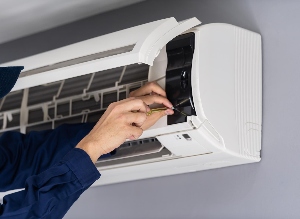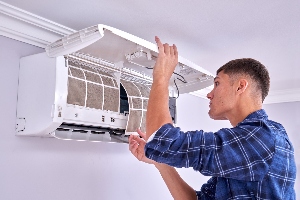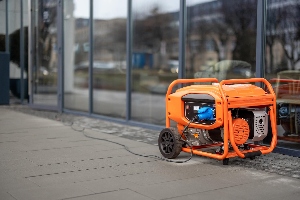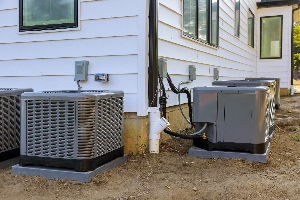Some furnace repair are best left to the experts, and we'll help you spot signs that it's time to call a professional. Safety always comes first when dealing with gas or oil furnaces.
Furnace problems can be a real headache, especially during cold winter months. However, many common issues can be fixed without calling a professional. Regular furnace maintenance and simple DIY repairs can save money and keep your home warm.
We'll walk you through easy troubleshooting steps, from checking the thermostat to cleaning filters, to get your furnace back up and running. By following our guide, you'll be able to tackle minor issues and know when to get help.
Here's what you'll learn:
- How does a furnace work?
- Furnace maintenance checklist every homeowner should follow
- Furnace problems and how to fix them
- When should you call a professional for furnace repair?
Good reading!
How does a furnace work?
Furnaces are complex heating systems with many vital parts. In this article, we'll explore the main types of furnaces and break down their key components to help you better understand how your home stays warm.
What are the main types of furnaces?
Gas furnaces use natural gas or propane to create heat. They ignite the fuel in a combustion chamber, warming the heat exchanger. A blower fan pushes air over the heat exchanger and through your home's ducts.
Electric furnaces work differently. They use electric heating elements, similar to a giant hair dryer. As air passes over these hot coils, it warms up before being distributed.
Heat pumps can both heat and cool homes. In winter, they extract heat from the outside air and move it indoors. This process reverses in summer for cooling.
What are the key parts of a furnace system?
Here’s a complete breakdown of the key components that make up a furnace system and what each part does. Understanding these elements can help you diagnose problems early and better communicate with your HVAC technician when service is needed
Furnace component
Function
What to check during maintenance
Thermostat
Sends signals to the furnace to turn on/off based on the room temperature setting.
Check for responsiveness and battery life. Make sure it’s set to “heat” and that the temperature setting is accurate.
Pilot Light / Ignition
Ignites the burner in gas furnaces. Newer models use electronic ignition systems instead of a pilot flame.
For standing pilots, ensure the flame is steady and blue. For electronic ignitions, test during startup to ensure proper function.
Flame Sensor
Detects whether a flame is present before allowing gas to continue flowing. Prevents gas leaks.
Clean the sensor gently with a fine abrasive pad if the furnace cycles on and off frequently. Replace if corroded.
Heat Exchanger
Transfers heat from combustion gases to the air that circulates through your home. Prevents exposure to toxic gases.
Look for cracks or rust during annual inspection. Cracks can leak carbon monoxide and require immediate replacement.
Blower Fan
Circulates warm air from the furnace into the home’s ductwork and vents.
Listen for unusual sounds. Clean blades and lubricate motor bearings. Ensure it starts and stops smoothly.
Air Filter
Traps dust and debris to prevent clogging and poor airflow.
Check monthly during heating season. Replace or wash as needed. A dirty filter is one of the most common causes of reduced efficiency.
Circuit Breaker
Cuts off power to the furnace if there’s an electrical overload or short.
Reset if tripped, but don’t ignore frequent trips, that could mean a wiring issue. Consult a technician if the breaker keeps flipping.
Limit Switch
Shuts off the burner if the furnace overheats and controls when the blower turns on/off.
Test with a multimeter if blower runs nonstop or furnace overheats. Replace if faulty.
Draft Inducer Fan
Clears out combustion gases and ensures proper airflow through the heat exchanger before ignition.
Listen for whining or grinding noises. Ensure the fan starts before ignition and runs steadily.
Gas Valve
Opens to allow gas into the combustion chamber when the furnace is in heating mode.
Test for continuity if the furnace isn't getting gas. Leave replacement or adjustment to a licensed technician.
Furnace maintenance checklist every homeowner should follow
Taking care of your furnace is key to keeping it running well. We'll cover the most essential maintenance tasks you can do at home and when to call in the pros.
According to the U.S. Department of Energy, heating accounts for approximately 45% of the average American household’s energy use. Maintaining your furnace through regular checks and timely repairs can significantly reduce your energy bills and increase system efficiency.
How often should you change your furnace filter?
Dirty filters can make your furnace work harder than necessary, so we recommend checking it every month during the heating season. Hold it up to a light source; it's time for a new one if you can't see through it.
Most furnaces use disposable filters, which come in different sizes. To ensure the right fit, slide the old filter out and insert the new one, following the airflow arrows on the frame. Some also have washable filters. If you have one, vacuum it off and rinse it with water. Let it dry completely before putting it back.
Signs your furnace isn’t working properly
Listen for odd noises when it turns on or off, and watch for short cycling, where the furnace turns on and off quickly. Check your thermostat settings. If rooms feel too hot or cold, your furnace might need attention. Also, look at your energy bills. A sudden jump could mean your furnace isn't running efficiently.
Ensure vents and registers aren't blocked by furniture or rugs, which helps air flow freely through your home. If you smell gas, leave your house immediately and call your gas company. Don't turn on lights or use your phone inside.
When should you schedule a furnace tune-up?
We suggest having a professional check your furnace once a year. Fall is a good time before the heating season starts.
An HVAC technician will:
- Clean the burners and check the heat exchanger
- Test safety controls and the thermostat
- Lubricate moving parts
- Check electrical connections
- Inspect the flue system
Furnace problems and how to fix them
Furnaces can develop various problems that affect their performance and comfort in your home.
Why is my furnace not producing heat?
When your furnace isn't producing heat, check the thermostat first, ensuring it's set to "heat" and higher than the room's current temperature. If the thermostat seems fine, inspect the air filter. A clogged filter can block airflow and cause the furnace to shut off. Replace dirty filters every 1-3 months.
Next, check the pilot light if you have an older furnace. If it's out, follow the manufacturer's instructions to relight it. For newer furnaces, look for error codes on the control board. Finally, check your circuit breaker, too. A tripped breaker can cut the furnace's power. If necessary, flip it back on.
What causes a furnace to short cycle or heat poorly?
Frequent cycling (turning on and off) often points to a clogged filter or improper airflow. Clean or replace the filter and ensure all vents are open and unblocked.
Check the location of your thermostat. If it's near a heat source or drafty area, it may misread the temperature and cause cycling. If your heat is inadequate, start by checking your ductwork for leaks. Then, seal any gaps you find with metal tape.
Ensure your furnace is the right size for your home. An undersized unit will struggle to heat correctly. Clean the blower assembly and check the fan belt, too. A dirty blower or loose belt can reduce airflow and heating efficiency.
Why is my furnace making noise or blowing cold air?
Unusual noises often indicate loose or worn parts. Rattling suggests a loose Panel, while squealing indicates a worn belt. Grinding noises are serious and usually require a professional. Turn off the furnace and call a technician.
Check if the blower runs when the burners are off for a furnace blowing cold air. This could mean a faulty limit switch. Ensure the gas supply is on and the pilot light is lit. If these are fine, the issue might be with the ignition system or gas valve. Additionally, clean or replace a dirty flame sensor. If it can't detect a flame, this part shuts off the gas, leading to blowing cold air.
When should you call a professional for furnace repair?
Some furnace issues need expert help, and you should call a professional if you notice these signs:
Strange noises from your furnace could mean serious problems. Banging, rattling, or screeching sounds aren't normal.
- A yellow or flickering burner flame is dangerous. It may indicate a gas leak or carbon monoxide problem. Leave your home immediately and get help.
- Sudden spikes in heating bills often indicate that your furnace isn't working correctly. A pro can find the cause and fix it.
- Your furnace keeps turning on and off.
- You can't get your thermostat to work correctly
- There's a strong gas smell near your furnace
- Your carbon monoxide alarm goes off
We always suggest getting help with gas or wiring, as messing with these without training is unsafe. Remember, trying to fix complex issues yourself can make things worse. It might even void your warranty. When in doubt, it's best to call a pro.
How to choose the right furnace technician for your home
Hiring the right HVAC professional can make all the difference when it comes to furnace performance, safety, and long-term efficiency.
While some minor furnace issues can be handled through DIY steps, repairs involving gas, electrical components, or deep system diagnostics should always be left to licensed professionals.
Start by confirming that the technician or HVAC company holds a valid contractor license in your state. Most states require HVAC professionals to be licensed, bonded, and insured. You can typically verify credentials through your state’s contractor licensing board or public regulatory database.
In addition to state licensing, prioritize technicians with NATE (North American Technician Excellence) certification, this is the industry standard for HVAC excellence. Technicians with this certification have proven expertise in areas like gas furnaces, air distribution, and heat pump systems.
Ask the following when hiring a professional:
- Are you licensed and insured in this state?
- Are your technicians NATE certified?
- Do you have experience with my specific furnace model?
- Can you provide references or verified reviews?
- Do you offer a written estimate before starting work?
Look for companies that provide transparent pricing, detailed maintenance plans, and emergency service availability. Good professionals will also take time to explain your system’s condition and what maintenance it needs.
Understanding local permits and inspection requirements
In most U.S. states and municipalities, any major furnace repair or replacement, especially if it involves gas lines, venting, or structural changes, requires a building permit. This ensures the work complies with safety and energy codes.
A qualified technician should handle all necessary paperwork and coordinate with local inspectors. The inspection process often includes:
- Verifying proper combustion and ventilation
- Checking that carbon monoxide emissions are within safe limits
- Ensuring safe and compliant gas or electrical connections
- Confirming proper sizing and airflow for the furnace
Even routine furnace replacements may trigger permit requirements, especially when altering the flue, gas line, or thermostat wiring. Always ask your technician:
“Is a permit needed for this job, and will you handle the inspection process?”
Failing to pull a permit can lead to fines, insurance issues, or problems during resale. Working with a professional who understands these local requirements ensures your home stays safe and up to code.
Conclusion
Furnace issues can be frustrating, especially in the colder months when your home’s comfort depends on reliable heating. By learning to handle minor problems and sticking to a regular maintenance schedule, you can extend the life of your system and avoid costly emergency repairs.
However, not every issue is a DIY fix. Knowing when to call a licensed professional is just as important as cleaning a filter or checking your thermostat. Safety comes first, particularly with gas lines, ignition systems, and carbon monoxide risks.
If you live in Nevada, ensure any professional you hire is licensed, insured, and compliant with state and county HVAC regulations. A properly maintained furnace is more than a convenience, it’s a safeguard for your health, comfort, and long-term savings.
Get in touch to arrange a professional inspection of your furnace or heating system.













